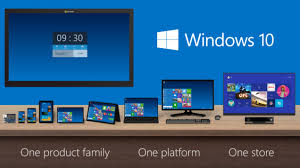Microsoft has finally announced their Windows 10 operating system, which was previewed last year. The company showed all the latest updates on the software front and also unveiled two new hardware – Microsoft Surface Hub and HoloLens. HoloLens is a holographic lens which has its own untethered computing system. The upcoming Windows 10 OS will be a free upgrade to those users who are using the most recent versions of the operating system.
 The event continued for two long hours and Microsoft made a slew of announcements. They announced their HoloLens headset which makes use of holograms to interact with natural gestures like pinch, zoom, touch, voice etc. It is a completely untethered mini-computer of a lens which looks like a goggle which has a CPU and a GPU and also a HPU or Holographic Processing Unit. It lets you see what’s in front of you, it lets you hear holograms behind you and also several other sensors work altogether. No official date has been announced for the release of the headset as of now but it has been revealed that it will come out while Windows 10 comes to the market, this autumn.
The event continued for two long hours and Microsoft made a slew of announcements. They announced their HoloLens headset which makes use of holograms to interact with natural gestures like pinch, zoom, touch, voice etc. It is a completely untethered mini-computer of a lens which looks like a goggle which has a CPU and a GPU and also a HPU or Holographic Processing Unit. It lets you see what’s in front of you, it lets you hear holograms behind you and also several other sensors work altogether. No official date has been announced for the release of the headset as of now but it has been revealed that it will come out while Windows 10 comes to the market, this autumn.
Windows 10 will start an era of unified platforms across desktop, mobile, laptop, tablet and all other devices, which will run on the same Windows 10 OS. This will help Windows users a lot and also app developers who will develop apps for all the platforms. Microsoft’s executive vice president of Operating Systems, Terry Myerson, announced that all the PCs and laptops running on Windows 7 and Windows 8.1 and all the mobile devices running on Windows Phone 8.1 OS will be upgraded to Windows 10 for free. Microsoft’s personal assistant Cortana will also come together with Windows 10 and will be available in all devices. Desktop versions will also enjoy Cortana’s search and reminder facilities. Cortana will be present as a search box beside the Start button on the desktop. Cortana supports seven languages and it can also open apps on your desktop like PowerPoint and Word. Cortana can also be used for dictating emails in Outlook by voice commands.
In the user interface too, some improvements have been announced as the Start Menu is back on the full screen instead of its limited view on Windows 8.1. The Action Centre has quick buttons to switch Wi-Fi and Bluetooth on and off. A new Notification Centre has also been introduced above the Action Centre which will be synced across devices. A single folder will comprise Control Panel and Settings menu now. If you use 2-in-1 mode, you can go from a desktop mode to a tablet mode by a notification and the full-screen will be then optimised for touch-based inputs. Similar apps will be workable across PCs, laptops, mobile phones and tablets. Outlook will be in-built with Word engine and the Calendar app will also be synced across devices. The Photo gallery app has also seen improvements in its design and it will also be synced across all devices. All pictures taken on the devices along with photographs on One Drive will be merged together in this gallery and the app will automatically delete duplicate files. It will also create Albums based on date, location and people in the photographs.
Spartan browser was doing rounds in the news since last few weeks and finally it has been unveiled at the event. It is a new browser which comes with in-built Cortana. Its reading mode puts articles in a layout and also offers a Reading List feature which syncs across all phones, saves pages for later reading, even offline. Windows 10 devices will also have in-built Xbox app which will allow users create their own avatar or log in using Xbox avatar. You can also record 30 seconds of gameplay which will be sent across to Xbox Live. It also has a feature called cross-play which lets you play with a friend using Windows 10 PC. The second hardware launched, Microsoft Surface Hub, targets enterprise and business segment and it’s a 213-cm (84-inch) 4K display which runs on Windows 10. It features dual cameras, multi-touchscreen display, speakers and the camera has some depth-sensing capabilities too.








